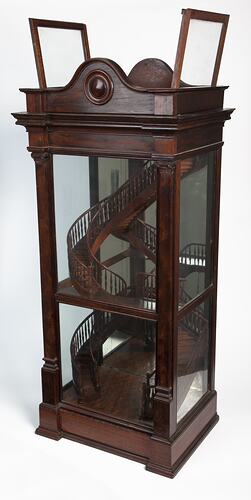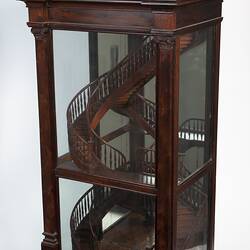The double spiral staircase model was crafted by Heinrich Munzel from Brazilwood. It was made in Pernambuco, Brazil between 1835 and 1850. It is probable that the model was made soon after Munzel's arrival in Brazil in 1835, as it would have been used by him to establish his name and demonstrate his craftsmanship. The staircase is enclosed in an attractive and carefully crafted display case with glass sides and a wooden floor and ceiling. A mirror is positioned on the inside rear wall and serves to expand the size and grandeur of the model staircase. The floor of the case has an ornamental inlaid design, in keeping with the elaborate style of the staircase.
Heinrich Munzel brought this model staircase with him to Australia in 1850, and in 1866 entered it in the Sandhurst Division of the Inter-Colonial Exhibition held in Melbourne, where it was awarded an Honourable Mention. This model was an important and portable demonstration of Munzel's skills as a master craftsman, and his entry into the Sandhurst Division of the 1866 Inter-Colonial Exhibition in Melbourne would have offered him an excellent way to promote his Bendigo business.
Brazilwood was highly sought after in Europe for its capacity for carving and twisting. It was also a valuable source of red dye and hardwood for construction. It gave the name to what was later to become Brazil. Excessive exploitation led to a steep decrease in the number of brazilwood trees in the 18th century, causing the collapse of this industry. The species is now listed as an endangered species by the International Union for Conservation of Nature (IUCN), and it is cited in the official list of endangered flora of Brazil.
Museum Victoria has three examples of Brazilwood, Caesalpinia Echinata, in the Economic Botany Collection.
Referenceshttp://en.wikipedia.org/wiki/Brazilwood


